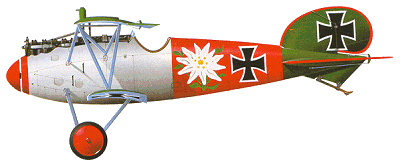|
| At the same time as the OAW received its first contract
for the D.III in April 1917, Albatros received an order
from Idflieg for 200 D.Vs, referred to as "lightened
D.Ills". The D.V retained the wings of the D.III
(although the aileron cables were led through the
upper wing), was powered by the high-compression
Mercedes D IlIa with oversize cylinders and offering
180hp, and mounted twin 7.92mm synchronised
LMG 08/15 machine guns. The D.V experienced a recurrence
of the wing failures (previously suffered by
the D.III) as early as May 1917. Four hundred more D.Vs
were ordered, nevertheless, in May 1917 and 300 in
July, after which the Idflieg terminated production in
favour of the D.Va which reverted to the D.Ill-type
aileron control cable arrangement and was reinforced
throughout. The last Albatros fighter to see operational
use in World War I, the D.Va arrived at the Front in
October 1917, by which time 1,612 fighters of this version had been ordered. Service of the D.Va peaked in
May 1918 when there were 928 (plus 131 D.Vs) in operational
use.

| MODEL | Albatros D.V |
| CREW | 1 |
| ENGINE | 1 x 180hp Mercedes IIIa |
| WEIGHTS |
| Take-off weight | 937 kg | 2066 lb |
| Empty weight | 687 kg | 1515 lb |
| DIMENSIONS |
| Wingspan | 9.04 m | 30 ft 8 in |
| Length | 7.33 m | 24 ft 1 in |
| Height | 2.70 m | 9 ft 10 in |
| Wing area | 21.20 m2 | 228.19 sq ft |
| PERFORMANCE |
| Max. speed | 185 km/h | 115 mph |
| Cruise speed | 157 km/h | 98 mph |
| Ceiling | 6100 m | 20000 ft |
| Rate of climb | 255 m/min | 850 ft/min |
| ARMAMENT | 2 x 7.92mm |
 | A three-view drawing (1648 x 1264) |
| jose calderon, e-mail, 28.04.2015 13:52 If anyone knows
Who are the guys in the picture reply | | rob dondorf, e-mail, 21.06.2012 23:22 Could some one explain how the aileron cables were rigged on the Albatros DV. I'm curently building the 1 /32 scale wingnut wings kit but the instructions don't really show how the aileron cables were rigged through the upper wing. It appears as though the cables cross over but I'm not sure. A diagram would be great. reply | | Klaatu, e-mail, 28.05.2011 04:56 The cross section of the D-V fuselage was more rounded than that of the D-III, and the shape of the rudder was more rounded. The biggest problem with this fighter was the weakness of the sesquiplane wing arrangement, which was carried over from the D-III. The narrow lower wing had only a single spar, and tended to twist, and even break, under the stress of diving or violent combat maneuvers. Albatros attempted to fix the problem on Later-production DVa aircraft by adding a small additional interplane strut to brace the lower wing, visible in the lower photo and in the 3-view drawing. It helped, but only up to a point. reply | | Bill Schmeal, e-mail, 10.02.2010 22:54 I think tthat this plane was one of the nicest to look at during the WWI era. reply | |
| | Chris in LA, e-mail, 04.02.2010 00:23 Nope, I'm wrong; this is the right plane. Fuselage was a development from the unsuccessful D.IV, wings returned to the D.III unequal-chord configuration. First deliveries of this plane began mid-1917. reply | | Chris in LA, e-mail, 02.02.2010 23:04 My memory may be faulty but I believe this plane was an update of the D.III, addressing structural flaws with the 'V' wing struts. The D.V had 'N' struts. The pictures here seem to be of the wrong plane? reply | | DICK GREENWOOD, e-mail, 17.01.2010 19:59 This is pretty advanced. Anyone know what year ? First and only plane I've seen with a reverse trailing 'camber'.
The performance would be interesting. It seems to have it all. reply | | PETER, e-mail, 01.03.2008 14:03 This is one of famoust WWI aircrafts reply |
|
Do you have any comments?
|
| 
COMPANY
PROFILE
All the World's Rotorcraft
|









